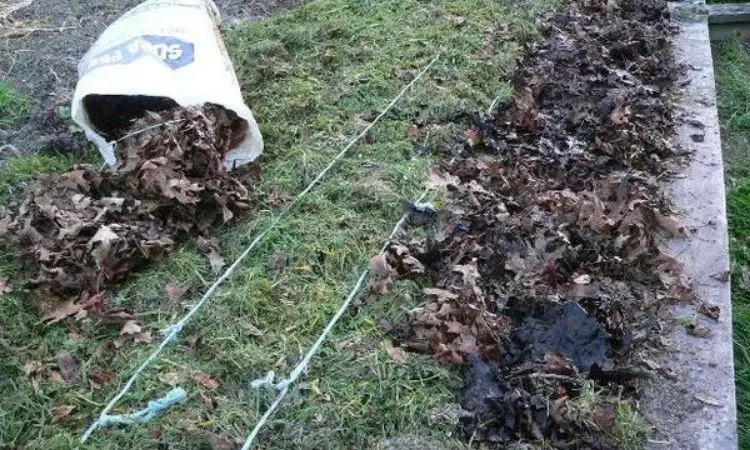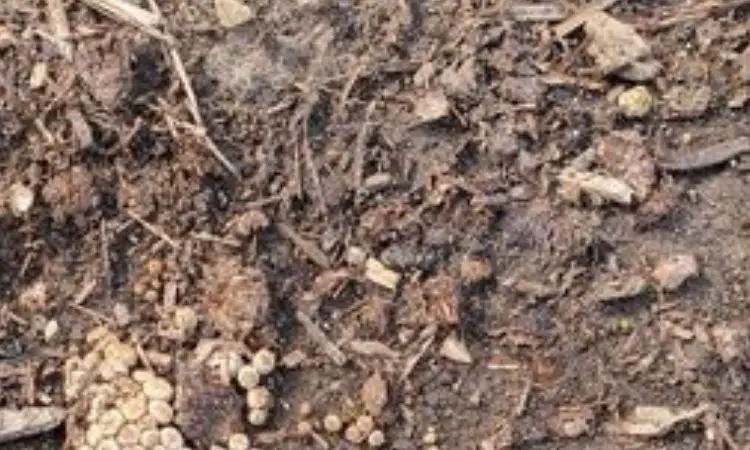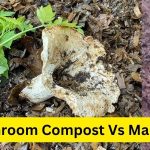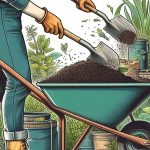Both compost and manure are natural fertilizers made from organic materials. Compost is produced by decomposing plant or kitchen waste, while manure is animal waste that has been aged or composted. According to UMass Amherst, manure is rich in nutrients, including trace elements necessary for crop growth. About 70-80% of nitrogen (N), 60-85% of phosphorus (P), and 80-90% of potassium (K) found in feeds are excreted in the manure.
Using organic materials to improve soil fertility is a sustainable practice that has gained popularity in recent years.
Both compost and manure provide essential nutrients to plants and increase the overall health of the soil. However, there are differences between the two in terms of nutrient content, application methods, and potential risks.
We will explore the advantages and disadvantages of using compost and manure, as well as their specific characteristics, to help you make an informed decision on which option is best for your gardening needs.
Whether you are a seasoned gardener or just starting, understanding the differences between compost and manure is crucial for successful plant growth. So, let’s dig in.
What Is The Importance Of Organic Gardening Success?
Organic gardening has gained immense popularity in recent years, and for good reason. By utilizing natural methods and materials, organic gardening ensures a healthier and more sustainable approach to nurturing plants and crops.
There are several key benefits that organic gardening brings to the table, making it an appealing choice for both amateur and experienced gardeners alike.
Contribution to the environment
One of the most significant advantages of organic gardening is its positive impact on the environment. Unlike conventional gardening which heavily relies on synthetic fertilizers and pesticides, organic gardening takes a more natural and eco-friendly approach.
Moreover, the absence of synthetic chemicals in organic gardening ensures the protection of both human health and the environment. Conventional gardening methods often expose individuals to harmful toxins through skin contact or inhalation, which can lead to various health issues.
What Is The Key Difference of Compost vs. Manure
Two fundamental components in organic gardening are compost and manure. While both are excellent sources of nutrients, they have different characteristics and applications in the garden. Understanding their key differences can help gardeners make informed choices when it comes to optimizing soil quality and plant growth.
Compost
Compost is the result of organic matter decomposition, such as kitchen scraps, leaves, grass clippings, and plant waste. Through the process of composting, these materials break down into a nutrient-rich soil amendment that improves soil structure, fertility, and moisture retention.
The benefits of using compost go beyond providing essential nutrients. It also enhances soil biodiversity, promotes beneficial microbial activity, and reduces the likelihood of plant diseases. Compost is known to promote stronger and healthier plant growth, resulting in higher yields and more vibrant gardens.
Manure
On the other hand, manure is animal waste that contains valuable nutrients for plants. It can come from various sources, such as cows, horses, chickens, or sheep. Manure is an excellent organic fertilizer that can significantly improve soil fertility and enhance plant growth.
However, compared to compost, manure is more concentrated and can be higher in certain nutrients like nitrogen, phosphorus, and potassium. This makes it a strong choice for plants that require a nutrient boost or have nutrient deficiencies.
It is important to note that fresh manure should be composted before application to eliminate any potential risks associated with pathogens or weed seeds. Composted manure not only eliminates these risks but also improves its texture and nutrient availability for plants.
Ultimately, both compost and manure play crucial roles in organic gardening, and their usage depends on specific garden needs and plant requirements.

How Compost Is Made?
Compost is a product of the natural decomposition process of organic matter. By providing the right conditions, organic matter such as food scraps, leaves, and yard waste can break down into nutrient-rich compost.
The process involves the activity of microorganisms, such as bacteria and fungi, which help break down the organic matter into simpler compounds.
These microorganisms require oxygen, moisture, and a proper balance of carbon and nitrogen to thrive and transform the waste into compost.
- Hot composting: This method involves building a compost pile that reaches high temperatures, typically between 130°F and 160°F (55°C and 71°C). The high heat speeds up the decomposition process, allowing for quicker compost production. This method requires regular turning and monitoring to ensure adequate oxygen supply and moisture levels.
- Cold composting: Cold composting is a slower process that allows organic matter to decompose naturally over time. This method does not require much maintenance or turning of the pile but may take several months to a year for the compost to fully mature.
Nutritional Benefits Of Compost
Compost is often described as black gold due to its exceptional nutritional qualities. It enriches the soil with a balanced blend of essential nutrients, organic matter, and beneficial microorganisms.
Some of the key benefits of adding compost to your soil include:
Improved soil structure: Compost helps improve soil structure by enhancing its ability to retain moisture, preventing soil erosion, and promoting better root development. It also loosens compacted soil, making it easier for plant roots to access water, air, and nutrients.
Increased nutrient availability: As compost decomposes, it releases essential nutrients such as nitrogen, phosphorus, and potassium that are essential for plant growth. These nutrients are slowly released over time, providing a steady supply for your plants without the risk of nutrient leaching or runoff.
Enhanced nutrient-holding capacity: Compost acts as a sponge, holding onto nutrients in the soil and preventing them from being washed away by heavy rainfall or overwatering. This helps reduce nutrient loss and ensures that plants have a constant supply of the nutrients they need.
Beneficial for beneficial microorganisms: Compost is teeming with beneficial microorganisms such as bacteria and fungi. These microorganisms help break down organic matter, improve soil fertility, and suppress harmful pathogens. Having a healthy population of beneficial microorganisms in your soil can lead to stronger, more resilient plants.
Adding Compost To The Soil
Adding compost to your soil is a straightforward process that can greatly benefit your garden. Here are some tips to ensure you are effectively incorporating compost into your soil:
- Prepare the soil: Before adding compost, ensure that the soil is properly prepared. Remove any weeds or debris and loosen the soil to improve aeration.
- Apply compost evenly: Spread a layer of compost over the soil surface. Aim for a thickness of about 2 to 3 inches (5 to 7.5 cm). You can use a rake or a garden fork to distribute the compost evenly.
- Mix compost with the soil: Once you have applied the compost, gently work it into the top few inches of the soil using a garden fork or a tiller. This will help incorporate the compost into the existing soil and allow the nutrients to become readily available to plant roots.
- Water the soil: After incorporating the compost, water the soil thoroughly to ensure the compost is properly moistened. This will help activate the nutrients and promote the growth of beneficial microorganisms.
Manure: Traditional Soil Enrichment Method
When it comes to enriching the soil and promoting healthy plant growth, manure is a traditional and time-tested method that has been used for centuries.
Different types of manure provide various nutritional benefits to the soil, making it an attractive option for farmers and gardeners alike.
Different Types Of Manure
In the world of manure, there are several options to choose from, each with its own set of characteristics and benefits. Some of the most commonly used types of manure include:
| Type of Manure | Description |
|---|---|
| Cow manure | Rich in organic matter and nutrients such as nitrogen, phosphorus, and potassium. |
| Chicken manure | High in nitrogen and other essential nutrients, making it an excellent choice for leafy green vegetables. |
| Horse manure | Contains a good balance of nutrients and organic matter, providing a slow-release source of nutrition for plants. |
| Sheep manure | Similar to cow manure, sheep manure is rich in nutrients and helps improve soil structure. |
Nutritional Benefits Of Manure
Manure offers a wide range of nutritional benefits for plants and the soil. Its high content of organic matter helps improve soil structure, allowing better water retention and root development. Additionally, manure serves as a slow-release source of nutrients, gradually releasing them as plants require.
Some of the key nutritional benefits provided by manure include:
- Nitrogen: Essential for promoting leafy growth and overall plant development.
- Phosphorus: Crucial for root development, flowering, and fruit production.
- Potassium: Important for overall plant health, disease resistance, and the development of strong stems and roots.
- Other micronutrients: Manure also contains trace amounts of essential micronutrients like calcium, magnesium, and iron, which are necessary for healthy plant growth.
Advantages And Challenges Of Using Manure
While manure offers several advantages when it comes to enriching the soil, it is important to weigh both the pros and cons before deciding to use it in your garden or farm. Here is a breakdown of the advantages and challenges associated with using manure:
Advantages:
- Organic matter: Manure improves soil structure by increasing organic matter content, which enhances soil fertility and moisture retention.
- Nutrient-rich: Different types of manure provide a wide range of essential nutrients, helping plants thrive and produce healthy, abundant yields.
- Eco-friendly: Using manure as a soil amendment reduces the need for synthetic fertilizers, promoting sustainable and environmentally friendly agricultural practices.
- Cost-effective: Manure is often readily available and can be a cost-effective alternative to commercial fertilizers.
Challenges:
- Odor: Certain types of manure may have a strong smell, which can be a deterrent for some gardeners.
- Potential weed seeds: Manure may contain weed seeds that can germinate in your garden.
- Imbalanced nutrient ratios: Using manure exclusively without considering the specific nutrient needs of your plants can lead to imbalances in nutrient ratios.
- Pathogens: If not properly handled or composted, manure can harbor harmful pathogens that could pose a risk to human health.
What Each Brings To The Table? (Nutrient Composition)
When it comes to enriching soil and providing plants with essential nutrients, both compost and manure play significant roles. Understanding the nutrient composition of each can help you make an informed decision about which option is best for your garden.
Let’s take a closer look at the macronutrients and micronutrients found in compost and manure.
Macronutrients And Micronutrients In Compost
Compost is often referred to as “black gold” in the gardening world for its wide array of nutrients. It is a rich organic matter composed of decayed plant material, kitchen scraps, leaves, and more. This organic matter undergoes a natural decomposition process, resulting in a product that is packed with beneficial nutrients.
- Nitrogen (N)
- Phosphorus (P)
- Potassium (K)
These macronutrients are essential for plant growth, aiding in the development of healthy roots, strong stems, and vibrant foliage. Furthermore, compost contains a broad range of micronutrients, including:
- Calcium (Ca)
- Magnesium (Mg)
- Zinc (Zn)
- Manganese (Mn)
- Copper (Cu)
- Boron (B)
The presence of these micronutrients in compost ensures that plants receive a well-rounded and balanced diet, promoting overall vigor and resilience.
Macronutrients And Micronutrients In Manure
Animal manure is a natural fertilizer that has been used for centuries in agriculture. It brings all the benefits of animal excrement to your garden. The composition of nutrients in manure can vary depending on the animal source and the type of bedding material used. Common types of manure include cows, horses, chickens, and sheep. Around 70-80% of nitrogen (N), 60-85% of phosphorus (P), and 80-90% of potassium (K) found in feeds are excreted in the manure.
How It Does Soil Structure Improvement By Enhancing Fertility And Drainage?
Enhance soil fertility and drainage by improving its structure through the use of compost or manure. Both are effective in nourishing plants and promoting healthy growth. Choose the best option to meet your specific needs, considering factors like nutrient levels and moisture retention.
Benefits Of Compost For Soil Structure
Compost is a valuable organic material that plays a significant role in enhancing soil structure for improved fertility and drainage. It serves as a natural soil conditioner, offering several benefits that positively impact the overall health of the soil. Let’s take a closer look at the benefits compost brings when it comes to soil structure improvement.
Improved soil aggregation
Compost acts as a binding agent, promoting the aggregation of soil particles. This aggregation, or clumping together of particles, creates pore spaces that allow for better aeration and water infiltration. These pore spaces also provide a favorable environment for beneficial soil organisms such as earthworms, insects, and microorganisms, which further contribute to soil health.
Enhanced water-holding capacity
One of the major benefits of compost is its ability to improve the water-holding capacity of the soil. As organic matter, compost retains moisture and releases it slowly to plants, preventing excessive water runoff and reducing the risk of soil erosion. This property is particularly beneficial in drought-prone areas or during periods of extended dry spells.
Promoted nutrient availability
Compost is rich in essential plant nutrients, including nitrogen, phosphorus, and potassium. These nutrients are released gradually as the organic matter in compost decomposes. This slow release ensures a steady supply of nutrients to plants, reducing the risk of nutrient leaching and maximizing their uptake. In addition, compost enhances the cation exchange capacity (CEC) of the soil, increasing its ability to retain and release nutrients over time.
Benefits Of Manure For Soil Structure
Manure, another organic amendment, also offers several remarkable benefits when it comes to improving soil structure. Farmers and gardeners have long recognized the value of using manure as a soil conditioner and nutrient source. Let’s explore the benefits that manure brings to soil structure and overall fertility.
Increased soil organic matter content
Manure contributes to the organic matter content of the soil, which is crucial for maintaining healthy soil structure. Organic matter improves soil fertility by providing a source of nutrients, enhancing soil structure, and promoting microbial activity. By incorporating manure, farmers can increase the organic matter content of their soil and enjoy the resulting benefits.
Improved soil tilth
The addition of manure can significantly improve soil tilth, referring to the physical condition of the soil. It helps to create a loose and crumbly soil structure, making it easier for plant roots to penetrate and water to infiltrate. This loose structure also promotes better air circulation within the soil, benefiting soil organisms and root respiration.
Increased microbial activity
Manure serves as a nutrient source for soil microbes, stimulating their activity and enhancing soil biological processes. These microbes break down organic matter, releasing nutrients and improving soil structure in the process. Increased microbial activity results in a more vibrant and fertile soil ecosystem, fostering plant growth and overall soil health.

How You Can Apply Compost In Soil?
When it comes to using compost in your garden or on your farm, there are several techniques you can employ to get the most out of this nutrient-rich material.
Direct Application
Direct application of compost involves spreading the compost directly onto the soil surface. This method is simple and effective, as it allows the compost to slowly break down and release nutrients into the soil. To apply compost directly, you can follow these steps:
- Prepare the area: Clear any weeds or debris from the soil surface.
- Spread the compost: Evenly distribute a layer of compost, typically around 1-2 inches thick, over the desired area.
- Work the compost into the soil: Use a garden fork or a rake to gently incorporate the compost into the top layer of soil.
- Water the area: After incorporating the compost, lightly water the area to help the compost settle and start its decomposition process.
Direct application is a great option for general soil enrichment, promoting overall plant health, and improving soil texture and water retention. It also helps to suppress weed growth and reduces the need for synthetic fertilizers.
Compost Tea
The concept of compost tea involves creating a nutrient-packed liquid by steeping compost in water. This liquid can then be applied directly to plants or as a foliar spray. To make compost tea, follow these steps:
- Gather the materials: You will need a bucket, water, compost, and a porous bag or strainer.
- Fill the bucket: Fill a bucket with water, leaving some space to accommodate the compost.
- Add the compost: Place the compost in a porous bag or strainer and submerge it in the water-filled bucket.
- Steep the compost: Let the compost steep in the water for 1-2 days, stirring it occasionally.
- Strain and apply: After the steeping process, strain the liquid to remove any solid particles. The resulting compost tea can then be applied to plants using a watering can or sprayer.
Compost tea serves as a liquid fertilizer that provides plants with an immediate nutrient boost. It enhances soil microbial activity and can also help control certain plant diseases.
Top Dressing
Top dressing involves applying a thin layer of compost to the soil surface around established plants. This technique is particularly useful for potted plants, container gardens, or beds with existing vegetation. Here’s how you can top dress with compost:
- Clear the area: Remove any weeds or debris from the designated planting area.
- Spread the compost: Apply a thin layer of compost, about 1/4 to 1/2 inch, around the base of the plant, avoiding direct contact with the stems or leaves.
- Lightly incorporate: Gently work the compost into the top layer of soil using your fingertips or a tool, ensuring it is evenly distributed.
- Water the area: After top dressing, water the area thoroughly, allowing the compost to settle and provide nutrients to the plants.
The top dressing technique helps replenish soil nutrients, improves moisture retention, and can assist in reducing weed growth. It acts as a slow-release fertilizer, nourishing plants over an extended period.
How You Can Use Manure? Fresh Vs. Aged Manure
One important consideration when using manure as a fertilizer is whether to use fresh or aged manure. Both types have their advantages and disadvantages.
Fresh manure, as the name suggests, is manure that has recently been collected and hasn’t had time to decompose. It is rich in nutrients and organic matter, making it a potent fertilizer.
However, fresh manure can also contain high levels of pathogens and weed seeds, which can be harmful to plants and create weed management challenges.
Aged manure, on the other hand, has undergone a natural decomposition process over time. This decomposition reduces the levels of pathogens and weed seeds, making aged manure safer to use.
Aged manure also has a lower nitrogen content compared to fresh manure, which can be advantageous as excessive nitrogen can cause plant burn. However, the nutrient content of aged manure is still significant and beneficial for plant growth.
Proper Handling And Storage
Handling and storing manure correctly is essential to maintain its nutrient content and minimize odors and potential environmental pollution.
When handling manure, it is essential to wear protective gear such as gloves and a mask to avoid direct contact with pathogens and inhaling potentially harmful gases. Handling should be done in a well-ventilated area to prevent the accumulation of toxic gases.
Storage of manure should be in proper containers or structures that prevent runoff and leaching. Ideally, manure storages should be covered to reduce odors and prevent rainwater from entering, which can cause nutrient loss and contamination of nearby water bodies.
Dos And Don’ts Of Manure Application
Applying manure correctly is crucial to ensure its benefits are maximized without causing harm. Here are some dos and don’ts to keep in mind:
- Do:
- Apply manure evenly to avoid nutrient imbalances.
- Incorporate manure into the soil to prevent nutrient runoff.
- Follow local regulations and guidelines regarding manure application rates and timings.
- Monitor soil and nutrient levels regularly to adjust manure application accordingly.
- Don’t:
- Apply manure to frozen or waterlogged soil, as the nutrients can be lost through runoff.
- Apply manure near water bodies, as it can contaminate the water with nutrients or pathogens.
- Apply manure in excessive amounts, as this can lead to nutrient imbalances and environmental pollution.
- Apply manure in windy conditions, as it can be blown away from the target area.
Conclusion
Choosing between compost and manure depends on your gardening goals and preferences. Compost is a versatile and nutrient-rich option, ideal for enriching soil, improving drainage, and promoting plant growth. On the other hand, manure is a natural and cost-effective alternative that provides essential nutrients to plants.

I am a graduate of Bangladesh Agricultural University, where I delved into various agricultural disciplines, equipping me with a profound understanding of agriculture. Beyond academics, I have hands-on experience in gardening and crop cultivation. My passion is to embrace sustainable farming and horticulture. With a BSc in Agriculture, I am dedicated to promoting environmentally conscious and efficient agrarian practices.
Bachelor of Science (BSc) in Agriculture (Hons.)
Master of Science. (Sustainable Agriculture & Food Security ) (MS)
Bangladesh Agricultural University

![Is Chicken Manure Good For Tomato Plants? [ Facts You Must Know] 1-24](https://broadpick.com/wp-content/uploads/2023/11/1-24-150x150.jpg)

